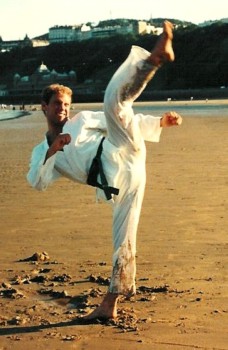ARTICLES The Differences Between Karate`s "Roundhouse Kick" & Taekwon-do`s "Turning Kick"! by W Rhee |
ARTICLES The Differences Between Karate`s "Roundhouse Kick" & Taekwon-do`s "Turning Kick"! by W Rhee |
Roundhouse kick = mawashi geri(Japanese) Turning kick = dollyo chagi(Korean) Although the roundhouse kick were the same in TKD as in karate, the differences began from late 60's when the dominant style (Gen. Choi's military style taught to the draftees) began changing the karate-origin kicks. The theory behind it was that when doing the Japanese karate roundhouse, the supporting foot is about 90 degrees to your target. This means that the kicking foot travels in a quarter of a circle (imagining your supporting foot to be center of the circle). The research team of military instructors theorized that if you shifted your body more by shifting the supporting foot to make 180 degrees to your target, you would get more power out of it. i.e. the kicking foot would travel a half a circle instead of a quarter circle, thus more acceleration, more speed, more power. The kick also works on a wet-towel snapping principle with the ball of the foot where all the force is concentrated at the final target. It is not a push through but rather a whip-cracking motion. This unleashes a tremendous amount of force to the focused target of solar plexus, ribs, or lower extremeties such as the knee joints. And it hurts like a mother on the receiving end. One of the most common questions you get with this techinique is, how are you supposed to curve your toes when you have shoes on? You are not. Since Gen. Choi's TKD was designed for the military, the roundhouse kick while wearing combat boots is to kick the opponent's target with the shoe tip. The training for this type of roundhouse kick is not done with any slap targets, but rather with a suspended heavy bags(40lbs. - 70 lbs.) when training for this, you shift your whole body weight into the kick. The bags will wail once you get this powerful technique right. The knee is bent and does snap out and tightens at the end. But the majority of acceleration comes from pivoting the body. After rise of the Olympic sport TKD, there were a lot of complaints about the "slow speed" of the above kick. Plus there were many complaints of toe injuries from kicking the bags with the ball of the foot. The research team for the Olympic TKD decided to adopt a different type of roundhouse kick. You do pivot your supporting foot for the acceleration as above, but an additional acceleration is provided by snapping out the knee joint to "slap" the target at high speed. This is further aided by the in-stepping and also kicking at 45 degree angle called the "bit-chagi". A lot of people believe this 45 degree roundhouse kick was invented by the latter Olympic TKD research team in the '80s. However, the older generation ITF related TKD has in one of their forms(Choong Moo pattern) from the 60's, but was not very much used in sparring. It was "forerunning" version of the modern day bit chagi. The Olympic TKD research team modified it into a high stance push-through kick(i.e. not a whip crack). In synopsis: There are two types of roundhouse kicks in TKD. The "old style" and the "new" style. Both are different from the traditional Japanese roundhouse kick called mawashi geri. The old style: 1. Pivots 180 degrees 2. Leans the whole body into the kick 3. Uses the ball of the foot to strike 4. Whip-cracking motion at the target 5. Speed acceleration via torque from slight twisting from opposite side in the beginning 6. Target-High, Middle, Low sections 7. Powerful 8. Most common complaint is the speed, but I notice this varies individually 9. Trained with suspended bags The new style(bit chagi): 1. Pivots 180 degrees 2. Does not lean whole body into the kick, only somewhat 3. Uses the in-step of the foot to strike 4. Knee whip motion and impact pushes beyond the target 5. Speed acceleration via pivoting of the body 180 degrees and using this momentum to accelerate the knee whip 6. Target-usually the mid-section 7. Not as powerful as the old style-force does not focus on one specific point, but dissipates into a large spot 8. Fast since it is launched in a 45 degree angle to the target and from a high stance 9. Trained with slap targets(usually) |

A nice turning kick by Lenny Ludlam |